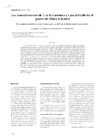Please use this identifier to cite or link to this item:
https://accedacris.ulpgc.es/jspui/handle/10553/57152
| DC Field | Value | Language |
|---|---|---|
| dc.contributor.author | Reguilón Bragado, Rosa María | en_US |
| dc.contributor.author | Arribas, A. | en_US |
| dc.contributor.author | Martín Izard, Agustín | en_US |
| dc.contributor.author | Mangas Viñuela, José | en_US |
| dc.date.accessioned | 2019-10-17T12:22:32Z | - |
| dc.date.available | 2019-10-17T12:22:32Z | - |
| dc.date.issued | 1996 | en_US |
| dc.identifier.issn | 0210-6558 | en_US |
| dc.identifier.other | Dialnet | |
| dc.identifier.uri | https://accedacris.ulpgc.es/handle/10553/57152 | - |
| dc.description.abstract | The U mineralizations that are estudied in this paper are hosted in Albalágranile. They are controled by late Hercinian vertical or subvertical faults, with an aproximate oriemation of N300E. The mineral associalion in thiem comprises pichblenda, coffinite, blackoxides, piryte mar casite, melnicovite and some sphalerite in La Carretona, and black oxides,pyríte and melnicovite in Casa del Gallo. In both cases the gangue is made up of quarlz, jasper and apatite. The origin of the uranium that gives rise to these mineralizations comes from the remobilizations of this element present e in the host granite, basically in the form of uraninite, as a consequence of the early hydrothermal weathering of these granites, which occurred during, discontinuous proceses arid upergenic weathering . Hence, we suggesl that the first mineralizing process of the uranium took place during the sub-solid state of the granite, as a consequence of the leaching of U due to the hydrothermal fluids during the Permian Period. The posibility of a remobilization of U during the late alpinefracturation cannot be excluided. Finally, from the end of the tertiary to the present the latest stage of weathering and a concentration of the U have occurred, forming the hexavalent minerals. | en_US |
| dc.language | spa | en_US |
| dc.relation.ispartof | Boletín de la Sociedad Española de Mineralogía | en_US |
| dc.source | Boletín de la Sociedad Española de Mineralogía [ISSN 0210-6558], v. 19 (1), p. 55-56 | en_US |
| dc.subject | 250611 Mineralogía | en_US |
| dc.subject.other | Granito | en_US |
| dc.subject.other | Albacete | en_US |
| dc.title | Las mineralizaciones de U de La Carretona y Casa del Gallo en el granito de Albalá (Cáceres) | en_US |
| dc.type | info:eu-repo/semantics/article | en_US |
| dc.type | Article | en_US |
| dc.identifier.url | http://dialnet.unirioja.es/servlet/articulo?codigo=4633002 | - |
| dc.description.lastpage | 56 | - |
| dc.identifier.issue | 1 | - |
| dc.description.firstpage | 55 | - |
| dc.relation.volume | 19 | - |
| dc.investigacion | Ciencias | en_US |
| dc.type2 | Artículo | en_US |
| dc.contributor.authordialnetid | No ID | - |
| dc.contributor.authordialnetid | No ID | - |
| dc.contributor.authordialnetid | No ID | - |
| dc.contributor.authordialnetid | 964784 | - |
| dc.identifier.dialnet | 4633002ARTREV | - |
| dc.identifier.ulpgc | Sí | es |
| item.grantfulltext | open | - |
| item.fulltext | Con texto completo | - |
| crisitem.author.dept | GIR IOCAG: Geología Aplicada y Regional | - |
| crisitem.author.dept | IU de Oceanografía y Cambio Global | - |
| crisitem.author.dept | Departamento de Física | - |
| crisitem.author.orcid | 0000-0002-3286-743X | - |
| crisitem.author.parentorg | IU de Oceanografía y Cambio Global | - |
| crisitem.author.fullName | Mangas Viñuela, José | - |
| Appears in Collections: | Artículos | |
Page view(s)
137
checked on May 17, 2025
Download(s)
145
checked on May 17, 2025
Google ScholarTM
Check
Share
Export metadata
Items in accedaCRIS are protected by copyright, with all rights reserved, unless otherwise indicated.
